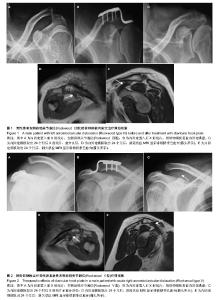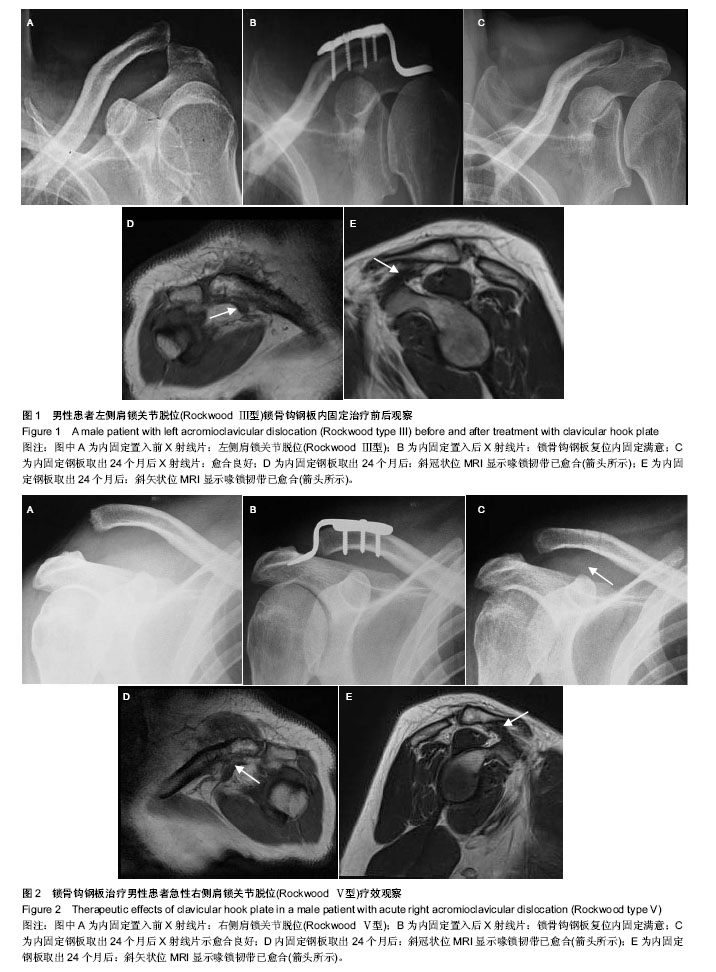| [1] Warth RJ, Martetschläger F, Gaskill TR, et al. Acromioclavicular joint separations. Curr Rev Musculoskelet Med. 2013;6(1):71-78.
[2] Ha AS, Petscavage-Thomas JM, Tagoylo GH. Acromioclavicular joint: the other joint in the shoulder. AJR Am J Roentgenol. 2014;202(2):375-385.
[3] Kim AC, Matcuk G, Patel D, et al. Acromioclavicular joint injuries and reconstructions: a review of expected imaging findings and potential complications. Emerg Radiol. 2012; 19(5):399-413.
[4] Beitzel K, Cote MP, Apostolakos J, et al. Current concepts in the treatment of acromioclavicular joint dislocations. Arthroscopy. 2013;29(2):387-397.
[5] Willimon SC, Gaskill TR, Millett PJ. Acromioclavicular joint injuries: anatomy, diagnosis, and treatment. Phys Sportsmed. 2011;39(1):116-122.
[6] Eschler A, Gradl G, Gierer P, et al. Hook plate fixation for acromioclavicular joint separations restores coracoclavicular distance more accurately than PDS augmentation, however presents with a high rate of acromial osteolysis. Arch Orthop Trauma Surg. 2012;132(1):33-39.
[7] Smith TO, Chester R, Pearse EO, et al. Operative versus non-operative management following Rockwood grade III acromioclavicular separation: a meta-analysis of the current evidence base. J Orthop Traumatol. 2011;12(1):19-27.
[8] Trainer G, Arciero RA, Mazzocca AD. Practical management of grade III acromioclavicular separations. Clin J Sport Med. 2008;18(2):162-166.
[9] Gstettner C, Taubor M, Hitzl W, et al. Rockwood type III acromioclavicular dislocation: surgical versus conservative treatment. J Shoulder Elbow Surg. 2008;17(2):220-225.
[10] 刘松,秦士吉,张英泽.肩锁关节脱位的手术治疗进展[J]. 中华创伤骨科杂志,2013,15(4):349-351.
[11] 蔡宇,王凯,梁晶峰.肩锁关节脱位重建:金属植入物的选择[J]. 中国组织工程研究与临床康复,2011,15(4):721-724.
[12] Faraj AA, Ketzer B. The use of a hook-plate in the management of acromioclavicular injuries. Report of ten cases. Acta Orthop Belg. 2001;67(5):448-451.
[13] De Baets T, Truijen J, Driesen R, et al. The treatment of acromioclavicular joint dislocation Tossy grade III with a clavicle hook plate. Acta Orthop Belg. 2004;70(6):515-519.
[14] Nadarajah R, Mahaluxmivala J, Amin A, et al. Clavicular hook-plate: complications of retaining the implant. Injury. 2005;36(5):681-683.
[15] Di Francesco A, Zoccali C, Colafarina O, et al. The use of hook plate in type III and V acromio-clavicular Rockwood dislocations: clinical and radiological midterm results and MRI evaluation in 42 patients. Injury. 2012;43(2):147-152.
[16] 仲飙,陈华,孙辉,等.锁骨钩钢板治疗TossyⅢ型肩锁关节脱位的疗效[J].中华创伤骨科杂志,2008,10(1):41-43.
[17] 吴添龙,涂以济,陈伟才,等.锁骨钩钢板治疗急性肩锁关节脱位喙锁韧带重建与否的疗效比较[J].中国矫形外科杂志,2013,21(16): 1597-1600.
[18] Schaefer FK, Schaefer PJ, Brossmann J, et al. Experimental and clinical evaluation of acromioclavicular joint structures with new scan orientations in MRI. Eur Radiol. 2006;16(7): 1488-1493.
[19] Alyas F, Curtis M, Speed C, et al. MR imaging appearances of acromioclavicular joint dislocation. Radiographics. 2008;28(2): 463-479.
[20] 张伟伟,王诗波,冯彦华,等.肩锁固定和喙锁固定治疗肩锁关节脱位的疗效比较[J].中国矫形外科杂志,2012,20(20):1829-1832.
[21] 张伟伟,王诗波,冯彦华,等.肩锁与喙锁关节植入物内固定治疗肩锁关节脱位疗效比较的Meta分析[J].中国组织工程研究,2012, 16(48):8997-9001.
[22] Moinfar AR, Murthi AM. Anatomy of the pectoralis minor tendon and its use in acromioclavicular joint reconstruction. J Shoulder Elbow Surg. 2007; 16(3): 339-346.
[23] Walz L, Salzmann GM, Fabbro T, et al. The anatomic reconstruction of acromioclavicular joint dislocations using 2 TightRope devices: a biomechanical study. Am J Sports Med. 2008;36(12):2398-2406.
[24] Struhl S. Double endobutton technique for repair of complete acromioclavicular joint dislocations. Techn Shoulder Elbow Surg. 2007;8(4):175-179.
[25] 林朝晖,林凤飞,郑明,等.线缆重建喙锁韧带治疗肩锁关节脱位[J]. 中国骨与关节损伤杂志,2011,26(9):827-828.
[26] 刘伯龄,张森,吴建军,等.钛缆结合钛网板与锁骨钩钢板治疗完全性肩锁关节脱位临床疗效观察[J].中国矫形外科杂志,2011, 19(16):1329-1331.
[27] 毛小成,赵枫,曹杰,等. LARS人工韧带重建喙锁韧带治疗肩锁关节脱位[J].中国骨与关节损伤杂志,2011,26(1):64-65.
[28] 陈云丰,陆叶,王海明,等. ENDOBUTT0N技术重建喙锁韧带治疗肩锁关节脱位[J].中华创伤骨科杂志,2011,13(6):539-543.
[29] 许福生,李桓毅,史源欣,等.双Endobutton技术与锁骨钩钢板治疗TossyⅢ型肩锁关节脱位的疗效比较[J].中华创伤骨科杂志, 2013,15(4):283-287.
[30] 汪李军,杨惠林,刘方刚,等.三重带袢纽扣钢板与锁骨钩钢板治疗急性肩锁关节脱位的疗效比较[J].中国矫形外科杂志,2012, 20(8):700-703.
[31] 王海明,陈云丰,陆叶,等. Triple-Endobutton技术与锁骨钩钢板置入治疗肩锁关节脱位的比较[J].中国组织工程研究,2012, 16(17):3105-3110. |

